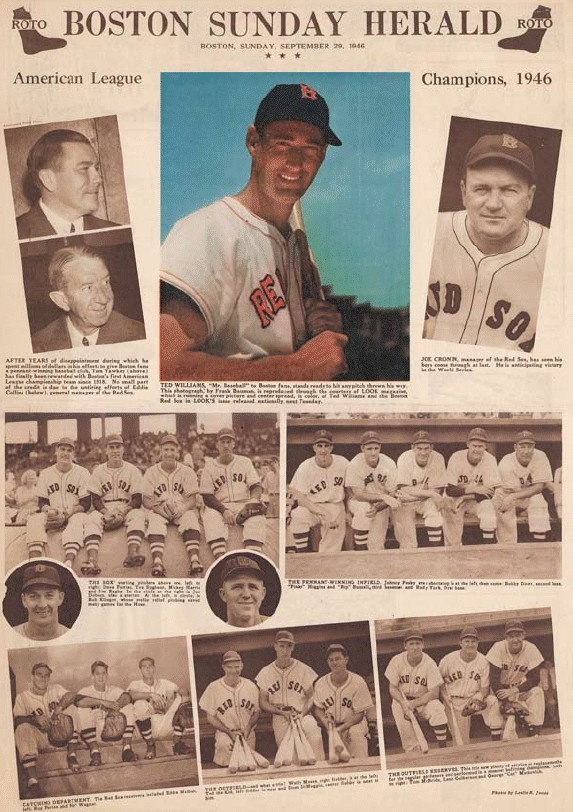- Relief printing
- Intaglio and planographic printing
- Color printing
- Bits and pieces
- Early photography in silver
- Non-silver processes
- Modern photography
- Color notes
- Color photography
- Photography in ink: relief and intaglio printing
- Photography in ink: planographic printing
- Digital processes
- Where do we go from here?
Rotogravure using mechanical screens

Rotogravure. Leslie R. Jones. American League Champions from Boston Sunday Herald, September 29, 1946. 1946. 22 1/2 x 15 1/4" (57.2 x 38.7 cm). Courtesy Boston Herald. The designer of this rotogravure sheet is unknown.
Photogravure was a hand process. The aquatint was applied to a flat plate, etched in a sequence of trays, then inked and wiped by hand, and finally run through a press—as often as not driven by a hand-operated wheel. This great process could not enter the long-edition book world until it left the hand behind and became mechanized. This changeover took place early in the twentieth century. The first thing to go was the aquatint. Finely ruled halftone screens were around by that time, and specialized ones were made for gravure that didn’t use dots but instead held a fine screen, a rectilinear grid much like a window screen but in negative form. This screen was exposed to the carbon tissue first and the picture positive was exposed afterwards. Once transferred to the plate, the screen image protected the copper, so that the etching took place only in the screen’s tiny “windows.”
The random cells of the aquatint were thus replaced by square ones, absolutely predictable in form. The next change was to get rid of the flat plate; now the etching was done on thin copper sheets—about .025 inch thick (.06 mm)—that could be wrapped around a cylinder. Later on even this plate disappeared, replaced by chrome-faced cylinders with copper electroplated onto them in which the image was etched. The remaining problem to be solved was the wiping, for which a tool was invented called the “doctor blade.” This device, acting like a windshield wiper, ran across the plate surface and removed all the ink from the top but not from the printing cells. The old stiff gravure ink was changed to a more fluid one, and the doctor blade became a very long, thin band of metal that wound steadily across the plate as it wiped, to avoid nicks and grit that could create lines running through the whole print run. The old flat-plate photogravure had been called “hand,” “grain,” or “helio” gravure. The new mechanized form was called “rotogravure,” reflecting the purely rotary nature of the presses: not just the plate but the paper were handled by cylinders. This was what made high-speed printing possible. The new gravure retained much of the beauty of the old hand methods. It could use matte inks, and the plates were still made from film positives, so a long tonal range was attainable. The fine printing cells, holding ink of variable thickness, gave a true rendition of tone. This printing became the standard for photographically illustrated books in Europe. The French and Swiss printers reached a high point in bookmaking with Cartier-Bresson’s The Decisive Moment and Frank’s The Americans (there respectively titled Images à la sauvette and Les Américains), but many other glorious books made in this process are still out there and available inexpensively in used-book stores. The pictures may or may not be great art but the printing is among the very best ever done.

